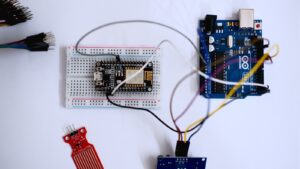The Importance of Securing Audit Tools in IoT Security Assessments
Understanding the Role of Audit Tools in IoT Security
Securing audit tools in IoT security assessments is therefore critical. These tools provide detailed insights into system vulnerabilities, and if compromised, they could be manipulated to either overlook certain weaknesses or introduce new ones. Such tampering could lead to significant security breaches, particularly in environments where IoT systems manage critical infrastructure, such as smart cities in Riyadh and Dubai. By ensuring that audit tools remain secure, organizations can prevent tampering and maintain the accuracy and reliability of their security assessments.
The threat landscape surrounding IoT is complex, with numerous vectors through which an attack can be launched. Audit tools, given their access to sensitive system information, are particularly attractive targets. If an attacker gains control over these tools, they could alter the results of a security audit, providing a false sense of security or masking vulnerabilities that could later be exploited. As such, organizations must prioritize the security of their audit tools to safeguard against these potential threats.
Best Practices for Securing Audit Tools in IoT Environments
To protect audit tools from tampering during IoT security assessments, organizations must adopt a multi-layered approach that encompasses both technological and procedural measures. One of the most effective strategies is to implement strong access controls. This involves restricting access to audit tools to only authorized personnel and ensuring that these individuals are subject to rigorous authentication processes, such as multi-factor authentication (MFA). By limiting who can access and use these tools, organizations can reduce the risk of unauthorized tampering.
Another key measure is to regularly update and patch the audit tools themselves. Just as with any software, audit tools can contain vulnerabilities that, if left unaddressed, could be exploited by attackers. Regular updates and patches are essential to closing these security gaps and ensuring that the tools remain effective in identifying and addressing IoT vulnerabilities. Additionally, organizations should implement continuous monitoring of these tools to detect any signs of tampering or unauthorized access. This real-time monitoring can provide early warnings of potential threats, allowing for swift action to mitigate risks.
Furthermore, the integrity of the audit tools can be reinforced through the use of encryption. Encrypting the data that these tools handle ensures that even if an attacker gains access to the tools, they will be unable to decipher the sensitive information they contain. Encryption also protects the audit results from being altered or tampered with, ensuring that the assessments reflect the true security posture of the IoT environment. Combined with access controls and regular updates, encryption forms a robust defense against the tampering of audit tools.
Building a Secure Framework for IoT Security Assessments
Securing audit tools is not an isolated task but rather part of a broader framework for IoT security assessments. This framework should integrate the secure management of audit tools with other critical security processes, ensuring a comprehensive approach to IoT security. For organizations in regions like Saudi Arabia and the UAE, where IoT is becoming increasingly integral to smart city initiatives and other advanced projects, a secure assessment framework is vital.
An effective framework begins with a thorough risk assessment to identify the potential threats to audit tools within the IoT environment. This assessment should consider factors such as the types of devices connected to the network, the sensitivity of the data being handled, and the likelihood of various attack vectors. Based on this assessment, organizations can tailor their security measures to address the specific risks identified, ensuring that their audit tools are adequately protected.
Training and awareness programs are also crucial components of a secure IoT assessment framework. Personnel involved in the use of audit tools must be educated on the importance of securing these tools and trained in best practices for doing so. This includes understanding how to implement and maintain access controls, recognizing signs of tampering, and responding effectively to potential security incidents. By fostering a culture of security awareness, organizations can enhance the overall effectiveness of their IoT security assessments.
Lastly, organizations should conduct regular reviews and audits of their own security practices to ensure that the measures in place remain effective over time. As the threat landscape evolves, so too must the strategies used to protect audit tools and other critical security assets. Regular reviews allow organizations to adapt to new threats and continue to safeguard their IoT environments effectively.
The Broader Impact of Secure Audit Tools on IoT Security
Ensuring Accuracy and Integrity in Security Assessments
The security of audit tools directly impacts the accuracy and integrity of IoT security assessments. In regions like Dubai and Riyadh, where IoT systems are increasingly deployed to support smart city initiatives, the reliability of security assessments is crucial. Any tampering with audit tools can lead to inaccurate assessments, which in turn could leave critical vulnerabilities unaddressed. This not only undermines the security of the IoT environment but also erodes trust in the digital infrastructure that underpins modern cities.
Accurate security assessments are essential for identifying and mitigating risks before they can be exploited. When audit tools are secure, organizations can have confidence in the results of their assessments and take proactive measures to address any vulnerabilities identified. This proactive approach is particularly important in environments where IoT systems control critical infrastructure, such as power grids, transportation networks, and healthcare systems. Ensuring the accuracy and integrity of these assessments is therefore not just a matter of security, but also of public safety and trust.
The Role of Audit Tools in Continuous IoT Security Improvement
Securing audit tools also plays a crucial role in the continuous improvement of IoT security. In a dynamic threat landscape, organizations must regularly assess and update their security measures to keep pace with emerging threats. Secure audit tools enable organizations to conduct ongoing security assessments, providing the data and insights needed to refine and enhance their security strategies over time.
For example, as new vulnerabilities are discovered in IoT devices and systems, secure audit tools can be used to reassess the environment and determine whether these vulnerabilities are present. This allows organizations to address potential risks before they can be exploited, maintaining a strong security posture. In regions like Saudi Arabia and the UAE, where IoT adoption is accelerating, continuous security improvement is essential to ensure that digital infrastructure remains resilient against evolving threats.
Conclusion: The Imperative of Securing Audit Tools in IoT Environments
In conclusion, securing audit tools is a critical component of IoT security assessments, particularly in regions leading the charge in digital transformation like Saudi Arabia, the UAE, Riyadh, and Dubai. By implementing strong access controls, regular updates, encryption, and continuous monitoring, organizations can protect their audit tools from tampering and ensure the accuracy and integrity of their security assessments. This, in turn, supports the broader goals of IoT security, enabling organizations to safeguard their digital infrastructure and maintain the trust of the public in an increasingly connected world. As IoT continues to expand, the importance of securing audit tools will only grow, making it an essential focus for any organization committed to cybersecurity excellence.
—
#IoTSecurity #AuditTools #Cybersecurity #SaudiArabia #UAE #Riyadh #Dubai #ArtificialIntelligence #Blockchain #GenerativeAI #ModernTechnology #BusinessSuccess #LeadershipSkills #ProjectManagement













